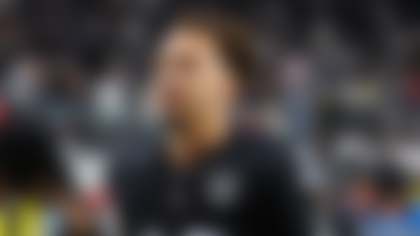Allen Robinson's route chart from Chicago's Week 1 loss wasn't exactly explosive.
Chicago targeted Robinson 11 times, resulting in six receptions for 35 yards. Math wizards around the globe will be happy to point out that total produces a per-reception average of less than six yards.
Robinson didn't see a single target of 10 or more yards. Most of his receptions came at 5 yards or fewer. He finished with 11 yards gained after the catch.
Robinson spoke on the matter, which gained traction via his route chart being posted to Twitter and largely seen as a disgrace to a player who has finished each of the last two seasons with 1,100 receiving yards.
"We knew what we were trying to get accomplished with trying to get the ball out and trying to get more yards after the catch rather than air yards, I guess, in certain spots," Robinson told reporters Wednesday, via the Chicago Tribune's Dan Wiederer.
The product was the result of a game plan that wasn't focused on stretching the field, and for good reason. For one, Los Angeles has a defense that includes nightmare-inducing Aaron Donald, and former Bears rusher Leonard Floyd, who set a career high with 10.5 sacks last season. Chicago also has a leaky offensive line that was already forced to adjust due to injury, forcing the Bears to sign and insert veteran tackle Jason Peters.
And of course, as we've all heard by now, the Bears are operating a passing game with Andy Dalton as its deliverer. This isn't exactly the greatest show on turf.
There's another element some might overlook, though. Los Angeles reached the statistical mountaintop last season by playing a defense that relies on playing soft coverage underneath while preventing offenses from gaining chunks of yards via shot plays. With Brandon Staley as its coordinator, the Rams played plenty of a modernized version of Cover 4, creating an umbrella-like effect -- Staley calls it putting a roof over the defense -- that keeps everything through the air in front of it. It limits an opponent's ability to quickly strike for big gains and touchdowns, and forces an offense to chip away by taking what the defense allows. The Athletic's Robert Mays wrote an excellent piece explaining this defense's advantages last week, with a case for it soon becoming the trendy new approach in the copycat NFL.
Though Staley is now with the Chargers as their head coach, much of Robinson's targets came against this type of defense, or a Cover 3 look that, again, gave space underneath while taking away the deep ball. Facing this type of coverage and a defense with a demonstrated ability to get after the quarterback -- a reminder, that quarterback was Dalton -- rather quickly meant Chicago was going to be forced to rely on underneath completions and hope for catch-and-run opportunities.
It wasn't just about Donald's presence, as most would have you believe.
"But it doesn't mean that you can't still get explosive [plays]," Bears coach Matt Nagy said, via the Chicago Sun-Times. "That's where we want to make sure that we are stretching the field vertically, and we weren't able to get that as much. And we kinda knew going into it, it was gonna be one of those types of games.
"That's just one of those deals where we want to, moving forward, try to do everything we can to keep defenses honest going downfield. But [it was] nothing to do with Andy as much as it was more of the scheme."
So don't take Robinson's strange route chart as an indicator of what's to come, or an indictment of Nagy's play-calling decisions. Sometimes you just have to take the best course available with the hope it produces a few defensive breakdowns and plays big enough to win you a game.
It didn't win the Bears a game. But we can guess Robinson's chart won't look like this on a weekly basis -- at least not until this style of defense becomes the dominant method in the NFL.












